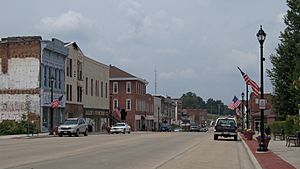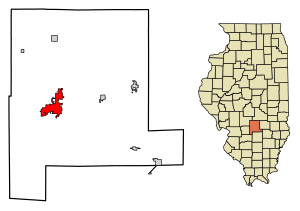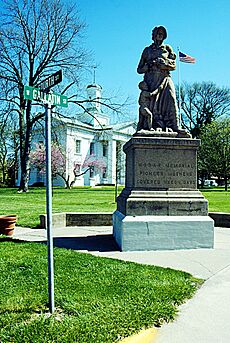Vandalia, Illinois facts for kids
Quick facts for kids
Vandalia
|
|
|---|---|
 |
|
| Motto(s):
"Oldest Existing Illinois Capital City"
|
|

Location of Vandalia in Fayette County, Illinois.
|
|

Location of Illinois in the United States
|
|
| Country | |
| State | |
| County | Fayette |
| Townships | Vandalia, Bear Grove, Sharon |
| Founded | 1819 |
| Area | |
| • Total | 8.16 sq mi (21.14 km2) |
| • Land | 8.15 sq mi (21.10 km2) |
| • Water | 0.02 sq mi (0.04 km2) |
| Elevation | 518 ft (158 m) |
| Population
(2020)
|
|
| • Total | 7,458 |
| • Density | 915.43/sq mi (353.46/km2) |
| Time zone | UTC−6 (CST) |
| • Summer (DST) | UTC−5 (CDT) |
| ZIP Code |
62471
|
| Area code(s) | 618 |
| FIPS code | 17-77317 |
| GNIS feature ID | 2397119 |
Vandalia is a city in Fayette County, Illinois, United States. It is also the county seat, which means it is where the county government is located. In 2020, about 7,458 people lived there.
Vandalia is located on the Kaskaskia River. It is about 60 miles (97 km) northeast of the St. Louis area. From 1819 to 1839, Vandalia was the state capital of Illinois. The state government later moved to Springfield. In the early 1800s, Vandalia was the end point of the National Road from the East Coast. Today, the Vandalia State House State Historic Site protects the old capital building. This building was first built in 1836.
Contents
History of Vandalia

Vandalia was started in 1819 to be the new capital city for Illinois. The old capital, Kaskaskia, often flooded. So, a new spot was quickly prepared for the Illinois General Assembly meeting in 1820. In 1821, Fayette County was created, and Vandalia became part of it.
Why is it Called Vandalia?
The exact reason for the name Vandalia is not fully known. Many books about Vandalia have different ideas. One story comes from a conversation with Colonel Greenup, who helped survey the town. He said that "Van" was suggested, meaning "vanguard" or the front of a movement. "Dalia" came from an old English word "dale," meaning a valley between hills. Colonel Greenup said he put the two words together to make "Vandalia."
Another idea is that the name came from the Vandalia colony. This was a failed attempt to create a new colony in what is now West Virginia and Kentucky. That colony was named after Queen Charlotte. She was believed to be related to the Wendish tribe, also called the Vandals.
A third theory suggests that the people who chose Vandalia as the capital thought the Vandals were a brave Native American tribe. However, the Vandals were actually a Germanic group from Europe.
Moving the Capital
When Vandalia was founded, a law said the capital would stay there for 20 years. But even before 20 years passed, more people had moved to the northern part of Illinois. In 1837, the state government decided to move the capital to Springfield.
On November 21, 1915, the famous Liberty Bell traveled through Vandalia. It was on its way back to Philadelphia, Pennsylvania after being shown at an event in San Francisco.
Education in Vandalia
Vandalia has a Board of Education that manages its public schools. Some of the schools include Jefferson Elementary School. The city's first high school opened in 1858.
Vandalia is also home to the Okaw Valley Area Vocational Center. This center teaches high school students useful job skills. Students from nearby towns like Greenville and Mulberry Grove also attend. Each year, the building trades class at the center buys land in Vandalia. They then build a house on it and sell it. Students have built and sold 33 homes so far.
Geography and Climate
Vandalia covers about 8.16 square miles (21.14 square kilometers). Most of this area is land. Vandalia is located near major roads. These include Interstate 70, U.S. Route 40 (the historic National Road), and U.S. Route 51.
Vandalia's Weather
| Climate data for Vandalia, Illinois (1991–2020 normals, extremes 1899–present) | |||||||||||||
|---|---|---|---|---|---|---|---|---|---|---|---|---|---|
| Month | Jan | Feb | Mar | Apr | May | Jun | Jul | Aug | Sep | Oct | Nov | Dec | Year |
| Record high °F (°C) | 72 (22) |
77 (25) |
84 (29) |
89 (32) |
94 (34) |
104 (40) |
111 (44) |
106 (41) |
98 (37) |
97 (36) |
81 (27) |
72 (22) |
111 (44) |
| Mean daily maximum °F (°C) | 36.9 (2.7) |
41.9 (5.5) |
52.7 (11.5) |
65.1 (18.4) |
74.9 (23.8) |
83.7 (28.7) |
86.8 (30.4) |
85.9 (29.9) |
79.6 (26.4) |
67.7 (19.8) |
53.7 (12.1) |
41.5 (5.3) |
64.2 (17.9) |
| Daily mean °F (°C) | 28.8 (−1.8) |
33.0 (0.6) |
42.9 (6.1) |
54.2 (12.3) |
64.6 (18.1) |
73.5 (23.1) |
76.7 (24.8) |
75.2 (24.0) |
67.7 (19.8) |
55.8 (13.2) |
43.9 (6.6) |
33.6 (0.9) |
54.2 (12.3) |
| Mean daily minimum °F (°C) | 20.7 (−6.3) |
24.2 (−4.3) |
33.2 (0.7) |
43.3 (6.3) |
54.2 (12.3) |
63.2 (17.3) |
66.6 (19.2) |
64.4 (18.0) |
55.8 (13.2) |
44.0 (6.7) |
34.1 (1.2) |
25.6 (−3.6) |
44.1 (6.7) |
| Record low °F (°C) | −22 (−30) |
−19 (−28) |
−9 (−23) |
20 (−7) |
28 (−2) |
39 (4) |
48 (9) |
41 (5) |
20 (−7) |
22 (−6) |
5 (−15) |
−17 (−27) |
−22 (−30) |
| Average precipitation inches (mm) | 2.97 (75) |
2.49 (63) |
3.32 (84) |
4.86 (123) |
5.30 (135) |
4.87 (124) |
3.90 (99) |
3.24 (82) |
3.07 (78) |
3.26 (83) |
3.76 (96) |
2.69 (68) |
43.73 (1,111) |
| Average precipitation days (≥ 0.01 in) | 8.9 | 7.2 | 9.5 | 11.0 | 12.4 | 9.9 | 8.0 | 7.4 | 6.8 | 8.2 | 9.2 | 8.3 | 106.8 |
| Source: NOAA | |||||||||||||
People of Vandalia
| Historical population | |||
|---|---|---|---|
| Census | Pop. | %± | |
| 1850 | 419 | — | |
| 1860 | 1,145 | 173.3% | |
| 1870 | 1,771 | 54.7% | |
| 1880 | 2,056 | 16.1% | |
| 1890 | 2,144 | 4.3% | |
| 1900 | 2,665 | 24.3% | |
| 1910 | 2,974 | 11.6% | |
| 1920 | 3,316 | 11.5% | |
| 1930 | 4,342 | 30.9% | |
| 1940 | 5,288 | 21.8% | |
| 1950 | 5,471 | 3.5% | |
| 1960 | 5,537 | 1.2% | |
| 1970 | 5,160 | −6.8% | |
| 1980 | 5,338 | 3.4% | |
| 1990 | 6,114 | 14.5% | |
| 2000 | 6,975 | 14.1% | |
| 2010 | 7,042 | 1.0% | |
| 2020 | 7,458 | 5.9% | |
| U.S. Decennial Census | |||
In 2020, Vandalia had 7,458 people living there. There were 2,253 households. About 27% of households had children under 18. About 40% were married couples.
The city's population includes people of various backgrounds. About 83.7% were White, and 10.24% were African American. About 6.91% of the population identified as Hispanic or Latino.
The average age in Vandalia was 38.5 years. About 16.2% of the people were under 18. About 16% were 65 years or older. The median income for a household was $35,862.
Notable People from Vandalia
- Alfred Elisha Ames – a politician and doctor.
- Josie Barnes – a professional bowler who won the 2021 U.S. Women's Open.
- Henry P. H. Bromwell – a U.S. Representative from Illinois.
- John J. Bullington – an Illinois politician.
- Levi Davis – an Illinois Auditor and lawyer.
- H. Joel Deckard – a U.S. Representative from Indiana.
- William Lee D. Ewing – a U.S. Senator and the fifth Governor of Illinois.
- William M. Farmer – a Chief Justice of the Illinois Supreme Court.
- Ferris Foreman – a politician and Army colonel.
- John W. Heavey – a U.S. Army brigadier general. He was also chief of the National Guard Bureau.
- Miles E. Mills – an Illinois politician and educator.
- Frederick Remann – an Illinois politician.
- June Squibb – an actress nominated for an Academy Award.
See also
 In Spanish: Vandalia (Illinois) para niños
In Spanish: Vandalia (Illinois) para niños

